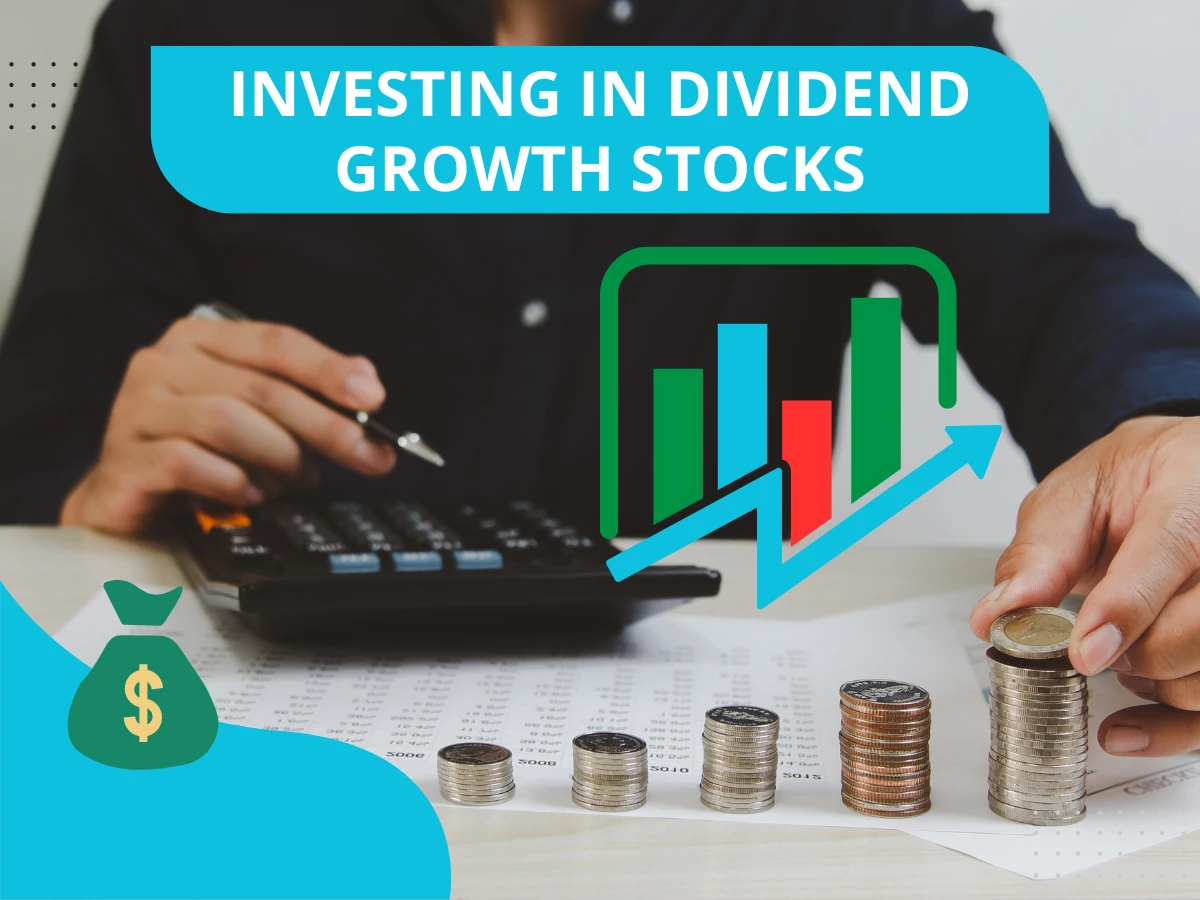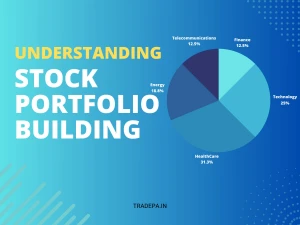Investing in Dividend Growth Stocks

Introduction
When building a resilient investment portfolio, one strategy that stands out is investing in dividend-growth stocks. But what exactly are dividend growth stocks, and why are they so crucial for investors seeking long-term wealth accumulation? Let's delve into the fundamentals to understand these stocks' allure and role in a diversified investment strategy.
What are Dividend Growth Stocks?
Dividend growth stocks are shares/equities of companies that always increase their dividend payouts to shareholders over time. Unlike fixed-income investments such as bonds, which offer predetermined interest payments, dividend growth stocks represent ownership in companies that share their profits directly with investors. These stocks typically belong to established companies with stable earnings and cash flow generation history.
Definition and Characteristics
At its core, dividend growth measures a company's ability to sustainably increase its dividend payments year after year. This growth reflects the company's financial strength, profitability, and management's confidence in its prospects. Characteristics of dividend growth stocks include:
- Consistent dividend increases: These stocks have a track record of raising dividends annually, showcasing their commitment to rewarding shareholders.
- Strong fundamentals: Dividend growth companies often boast solid financial metrics, including stable revenue growth, healthy profit margins, and manageable debt levels.
- Sector diversity: Dividend growth stocks can be found across various sectors, providing investors opportunities to diversify their portfolios.
- Long-term focus: Investors in dividend growth stocks typically adopt a buy-and-hold strategy, capitalizing on the power of compounding dividends over time.
Importance in Investment Portfolio
Integrating dividend growth stocks into an investment portfolio provides numerous advantages that contribute to long-term financial success:
- Income generation: Dividend-paying stocks provide a steady stream of passive income, which can supplement other sources of revenue and support a comfortable lifestyle, especially during retirement.
- Inflation protection: Dividend growth stocks have historically outpaced inflation, serving as a valuable safeguard against rising living costs and preserving purchasing power over time.
- Capital appreciation potential: Beyond dividends, these stocks offer the potential for share price appreciation, allowing investors to benefit from income and growth.
- Stability and resilience: Companies prioritizing dividend growth tend to be more resilient during economic downturns, as they typically possess strong balance sheets and sustainable business models.
- Portfolio diversification: Including dividend growth stocks in a diversified investment portfolio aids in spreading risk and reduce volatility, enhancing overall stability and risk-adjusted returns.
Different Types of Dividend Payouts
In Indian companies, dividends are distributed similarly to those in other countries, with variations based on regulatory requirements and corporate practices. Here are the different types of dividends commonly seen in Indian companies:
- Cash Dividends: Cash dividends are the most common type of dividend payment in Indian companies. They involve distributing a portion of the company's profits to shareholders through cash. Shareholders receive these payments directly into their bank accounts. Cash dividends are typically announced by the company's board of directors and are paid out on a specified date.
- Stock Dividends (Bonus Shares): Indian companies may also issue additional number of shares to shareholders as dividends, known as bonus shares. When a company issues bonus shares, existing shareholders receive additional shares proportional to their current holdings. While bonus shares do not provide immediate cash flow like cash dividends, they increase the shareholders' ownership stake in the company without requiring any additional investment.
- Dividend Reinvestment Plans (DRIPs): Some Indian companies offer their shareholders dividend reinvestment plans (DRIPs). With DRIPs, shareholders can reinvest their dividends to purchase additional shares of the company's stock instead of receiving cash dividends. This allows shareholders to compound their investment over time by acquiring more shares without incurring transaction costs.
- Interim Dividends: Interim dividends are dividends paid by a company before the end of its financial year. Indian companies may declare interim dividends if they have generated sufficient profits during the year and wish to distribute them to shareholders before the final determination of annual profits. Interim dividends are typically paid out during the financial year at the discretion of the company's board of directors.
- Final Dividends: Final dividends are dividends declared by a company at the end of its financial year, usually after its annual financial statements have been prepared and audited. After accounting for all expenses, taxes, and reserves, they represent the portion of profits the company distributes to shareholders. The company's board of directors proposes final dividends, which are subject to approval by shareholders at the annual general meeting (AGM).
These are some common types of dividends that Indian companies may distribute to their shareholders. Each dividend type has implications for investors, depending on their investment objectives and preferences for cash flow, capital appreciation, or reinvestment.
Benefits of Dividend Growth Stocks
Investing in dividend growth stocks offers many advantages for investors seeking stable income and long-term wealth accumulation. One of the primary benefits is the consistent income stream these stocks provide. Unlike bond interest payments, which may fluctuate or be subject to interest rate changes, dividends from dividend growth stocks tend to be more reliable, offering peace of mind and financial stability.
Consistent Income Stream
The advantages of regular dividend payments are manifold. Firstly, they provide investors with a tangible return on their investment, allowing them to enjoy the fruits of their investment in cash dividends. This steady income stream can be precious during economic uncertainty or market volatility when other sources of income may be less reliable. Additionally, dividend payments can be reinvested to purchase additional shares of the stock, effectively compounding the investment over time and accelerating the potential for wealth accumulation.
Stability in Volatile Markets
Another significant benefit of dividend growth stocks is their stability in volatile markets. Although stock prices may vary due to market conditions and economic factors, companies prioritizing dividend growth tend to be more resilient during downturns. These companies typically have strong fundamentals, including stable revenue streams, healthy profit margins, and robust cash flows. Dividends can act as a buffer against stock price declines, providing investors with a source of return even when capital appreciation may be limited. Overall, dividend growth stocks offer a combination of income stability and capital preservation that can help investors feel confident in navigating turbulent market environments.
Potential for Capital Appreciation
Dividend growth stocks also provide the potential for significant capital appreciation over the long term. Dividing growth correlates with stock price appreciation through the signalling effect it sends to the market. Companies that consistently raise dividends signal confidence in their financial health and prospects. This can attract investors interested in these companies' stability and growth potential, leading to increased demand for their shares and, consequently, driving up their stock prices. This potential for capital appreciation can instil hope in investors about the future value of their investments.
How Dividend Growth Correlates with Stock Price
Dividend reinvestment further reinforces the correlation between dividend growth and stock price appreciation. When investors reinvest their dividend payments to purchase additional shares of the stock, they effectively increase their ownership stake in the company. Over time, as the company continues to grow its earnings and dividends, the value of these additional shares also increases. This compounding effect can accumulate significant wealth over the long term as dividends and capital gains are reinvested to generate additional returns.
Historical Performance and Case Studies
Historical performance data and case studies provide compelling evidence of the potential for capital appreciation offered by dividend growth stocks. Numerous studies have shown that companies with a track record of increasing dividends tend to outperform the broader market over extended periods. By reinvesting dividends and leveraging the power of compounding, investors can significantly enhance their total returns and achieve their financial goals more effectively. Case studies of successful dividend growth stocks further illustrate the wealth-building potential of this investment strategy, inspiring investors to consider incorporating dividend growth stocks into their portfolios for long-term success.
Factors to Consider Before Investing
Before investing in dividend growth stocks, two key areas are company fundamentals, dividend policy, and history. Each provides valuable insights into the company's financial health and commitment to rewarding shareholders.
Company Fundamentals
Analyzing a company's fundamentals is crucial for assessing its financial health and stability. Key financial metrics such as cash flow, earnings and revenue should be analyzed to confirm the company has a solid foundation for future growth. By thoroughly analyzing company fundamentals, investors can identify dividend-growth stocks with strong underlying businesses and the potential for sustainable dividend growth.
Analyzing Financial Health and Stability
When evaluating company fundamentals, financial health and stability are essential. This includes examining the company's balance sheet to gauge its liquidity, solvency, and overall financial strength. Key indicators include a manageable debt-to-equity ratio, ample cash reserves, and consistent profitability.
Evaluating Earnings Growth and Payout Ratios
Another critical aspect of company fundamentals is evaluating earnings growth and payout ratios. Earnings growth is a crucial driver of dividend growth, as companies with growing profits can increase their dividend payments over time. Investors should seek out companies with consistent earnings growth and a track record of increasing dividends alongside earnings growth. Companies with moderate payout ratios and sufficient free cash flow are better positioned to maintain and grow their dividends in the future.
Dividend Policy and History
Understanding a company's dividend policy and history before investing in dividend-growth stocks is crucial. A company's dividend policy outlines its approach to distributing profits to shareholders and reflects its commitment to providing a reliable income stream. By assessing the importance of consistent dividend payments and analyzing dividend growth trends, investors can gain valuable insights into a company's financial management and shareholder-friendly practices.
Importance of Consistent Dividend Payments
Consistent dividend payments are a hallmark of dividend growth stocks and are significant in attracting investors seeking stable income. Companies prioritizing consistent dividend payments demonstrate financial discipline and a dedication to distributing profits to shareholders, even during challenging economic conditions. For income-oriented investors, reliable dividend payments provide a predictable source of cash flow that can supplement other sources of income and support a comfortable lifestyle.
Assessing Dividend Growth Trends
Analyzing dividend growth trends is essential for identifying companies with the potential for sustainable long-term dividend growth. Companies that consistently increase their dividends year after year signal solid financial performance and confidence in their prospects. Investors can assess a company's ability to generate growing profits and cash flow by examining dividend growth trends, which is essential for supporting future dividend increases. Additionally, evaluating dividend growth trends relative to earnings growth can provide insights into the company's dividend payout ratio and its capacity to sustain dividend growth.
Building a Dividend Growth Portfolio
Constructing a dividend growth portfolio requires careful planning and consideration of multiple factors to ensure long-term success. Two key aspects to focus on are diversification strategies and selecting quality dividend growth stocks. By diversifying across industries and sectors and choosing stocks with sustainable dividend growth potential, investors can build a resilient portfolio that generates consistent income and capital appreciation over time.
Choosing the right dividend growth stocks is paramount to building a successful dividend growth portfolio. Investors should focus on selecting stocks with solid fundamentals and sustainable dividend growth potential. By employing screening criteria and tools to identify high-quality dividend growth stocks, investors can build a portfolio that generates consistent income and capital appreciation over time.
Screening Criteria and Tools
Screening criteria and tools can help investors identify potential dividend growth stocks that meet their investment criteria. Common screening criteria include dividend yield, dividend growth rate, payout ratio, earnings growth, and financial stability. Investors can use stock screening tools from brokerage platforms or financial websites to filter stocks based on these criteria and identify candidates that meet their investment objectives. Additionally, investors might evaluate qualitative factors such as the company's competitive advantage, industry leadership, and management quality when screening for dividend growth stocks.
Identifying Sustainable Dividend Growth
Identifying sustainable dividend growth is essential for ensuring the long-term success of a dividend growth portfolio. Sustainable dividend growth depends on various factors, including the company's earnings growth, cash flow generation, and dividend payout ratio. Companies with growing earnings and cash flow are better positioned to support future dividend increases. In contrast, those with high dividend payout ratios may face challenges sustaining dividend growth over time. Additionally, investors should assess the company's financial stability, competitive position, and industry trends to gauge its ability to maintain and grow dividends in different market environments. By focusing on companies with sustainable dividend growth prospects, investors can build a resilient dividend growth portfolio that delivers consistent income and capital appreciation over the long term.
Common Mistakes to Avoid
Investing in dividend growth stocks can be rewarding, but it's essential to avoid common mistakes that could derail your investment strategy. Two prevalent pitfalls to avoid are chasing yield and ignoring company fundamentals.
Chasing Yield
One common mistake investors often must correct is chasing yield, prioritizing stocks with the highest dividend yields without considering other important factors. While high dividend yields may seem attractive, they can sometimes signal trouble. Stocks with exceptionally high yields may be experiencing financial distress or have unsustainable dividend payouts. Investors chasing yield may fall into the high-yield trap, where they invest in companies with deteriorating financial health and elevated risk levels. Instead of focusing solely on yield, investors should prioritize sustainable dividends from companies with solid fundamentals.
Risks of High-Yield Trap
The risks of falling into the high-yield trap can be significant, as investors may face the possibility of dividend cuts or suspensions if a company's financial situation deteriorates. Dividend cuts can lead to a decline in the stock price and a reduction in income for investors, ultimately undermining the long-term performance of their portfolios. To avoid the high-yield trap, investors should conduct thorough due diligence and assess the sustainability of a company's dividend payments. By focusing on companies with sustainable dividends and a history of dividend growth, investors can mitigate the risks associated with chasing yield and build a more resilient dividend growth portfolio.
Importance of Sustainable Dividends
Recognizing the importance of sustainable dividends is crucial for long-term investment success. Sustainable dividends are those that a company can afford to pay out of its earnings or cash flow without jeopardizing its financial health or future growth prospects. Companies that prioritize sustainable dividends demonstrate prudent financial management and a commitment to creating value for shareholders over the long term.
Ignoring Company Fundamentals
Another common mistake investors should avoid is ignoring company fundamentals when selecting dividend growth stocks. Focusing solely on a stock's dividend yield or recent performance without considering the underlying fundamentals can lead to poor investment decisions and suboptimal portfolio performance. Ignoring company fundamentals can result in investing in companies with weak financial health, limited growth prospects, or unsustainable dividend policies, which may lead to disappointment and underperformance.
Pitfalls of Neglecting Financial Health
Neglecting the financial health of a company can have detrimental consequences for investors. Companies with weak financial health may need help to generate consistent earnings and cash flow, making it challenging to sustain dividend payments over the long term. Ignoring key financial metrics such as revenue growth, profit margins, debt levels, and free cash flow can expose investors to unexpected downturns or adverse market conditions. To avoid the pitfalls of neglecting financial health, investors should perform thorough research and analysis to assess a company's financial strength and stability before investing in its stock.
Long-Term Impact on Portfolio Performance
The long-term impact of ignoring company fundamentals can be significant, affecting the overall performance of an investor's portfolio. Investing in companies with weak financial health or unsustainable dividend policies can lead to dividend cuts, stock price declines, and diminished returns over time. By paying attention to company fundamentals, investors may take advantage of opportunities to invest in high-quality dividend growth stocks with solid earnings growth potential and sustainable dividend policies. To optimize portfolio performance and achieve long-term investment success, investors should prioritize thorough due diligence and select dividend growth stocks with solid fundamentals and promising growth prospects.
Conclusion
Investing in dividend growth stocks can be rewarding for investors seeking consistent income and long-term wealth accumulation. However, it's essential to avoid common mistakes that could undermine your investment goals. Investors can build a resilient dividend growth portfolio that withstands market fluctuations and delivers sustainable returns over time by avoiding pitfalls such as chasing yield and ignoring company fundamentals.
Focusing on sustainable dividends from companies with robust financial health, stable earnings growth, and a history of consistent dividend payments is paramount. By prioritizing quality over yield and conducting thorough research and analysis, investors can identify dividend growth stocks with the potential for sustainable income and capital appreciation.
Investing in dividend growth stocks requires discipline, patience, and a long-term perspective. By staying vigilant, avoiding common mistakes, and adhering to sound investment principles, investors can build a portfolio that generates steady income, preserves purchasing power, and helps achieve their financial goals over the long term.








